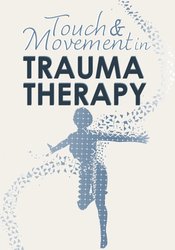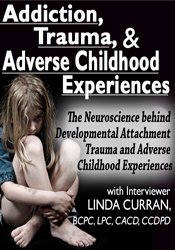What You’ll Discover in Linda Curran, Betsy Polatin Touch & Movement in Trauma Therapy
- Faculty:
- Linda Curran | Betsy Polatin
- Duration:
- 7 Hours 59 Minutes
- Format:
- Audio and video
- Copyright:
- Jul 12, 2018,
Description
Think about your traumatized clients. Do you ask yourself these questions? “why are my clients stuck?” Oder “why aren’t they getting better?”
Trauma The mind, brain, and body are all affected. Effective therapy must address all three. Interventions that heal the autonomic nervous systems and those that address internal organs and the body are both necessary. Which of these do you use with your clients?
Author and specialist in join movement The Actor’s Secret, Betsy Polatin MFA, SEP, Trauma specialist Linda Curran BCPC, LPC, CACD, CCDPD, Learn how to deal with trauma in A bottom-Up fashion. You will gain techniques and resources that address sensory, motoric and somatic issues and encourage clients to turn their attention towards the internal sensations of position and movement, bodily pain, and sensing one’s internal state. You will be able use sensorimotor and somatic interventions such as those from the Alexander Technique, the Feldenkrais Method and Gestalt therapy.
This workshop will teach you a number of simple, but theoretically sound, body movements.-There are many techniques that can be used to treat simple, complex and developmental traumas.
Are you ready to expand your trauma intervention skills? Register today to start your journey towards more positive outcomes with your most traumatized clientele.
Handouts
| Manual Touch & Movement in Trauma Therapy (3.5 MB) | 27 pages | Available after Purchase |
Outline
Introduction Betsy Polatin Performance Training
Are Our Intentions in Harmony with the Results?
Traditional Patterns
Performance and Trauma
Somatic Experiencing
- Allowing our bodies to complete a response
- Understanding Our Patterns
- Let Go “Character”
The Actor’s Secret: A New Approach to Performance Training
Alexander Technique
- Support is Important
Breathing coordination
- 3 Dimensional Breathing
Somatic Experiencing
The Importance Of Movement
What can we do? “Use” Each Other
Effort & Energy
- Can You Do Less?
- Toned, but not tense
Client Demonstration
Touch & Movement
What Roles Do We Play?
How to Change Habitual Patterns Touch & Movement
Resourcing
- Internal Resources
- External Resources
Experiential Exercise: “Resources” Discussion
Trauma 101
“What Happened to You” vs. “What is Wrong With You”
Peter Levine’s View of Trauma
The Brain in The Palm of Your Hand by Dan Siegel
- Interpersonal Neurobiology
Overwhelm/Shutting down
Gestalt Therapy
The Arousal Cycle
Experiential Exercise: “Startle Exercise”
- Reset Breath
Orienting: Betsy Polatin
- Living in The Past vs. The Present
- Experiential Exercise: “Orienting”
- Demonstration of Orienting
- Differentiating
The Autonomic Nervous System Linda Curran
- Stephen Porges: Polyvagal Theory
- Tend/Befriend
- Fight/Fright/Freeze
- Collapse (Dorsal Vasgal Response).
- The Levels Of Physiological Arousal
- Experiential Exercise: “Tracking”
- Reptilian Brain (Sensations).
- Limbic (Feelings).
- Cognitive (Thinking).
- Support & Containment
- Tracking Demonstration
Stress Response
- Stress Event/Reaction
- Discharge Energy
- Equilibrium/Baseline
Freeze Response
- Sympathetic vs. Parasympathetic
- Defense Cascade
- Tonic Imobility
- Robert Scaer M.D. Interview
Regulation
- Interpersonal Regulation
- Self-Regulation
Experiential Exercise: Interoceptors & Discussion
Use of self
“How” vs. “What” You Can
Definition of “Use”
Two Concepts
- Support
- Suspension
Demonstration: “Support”
Wrap up & Conclusion
Awareness through Movement Feldenkrais Method
Method for hands-on use
Awareness through Movement Lessons
The Human Brain is Organized for Efficiency, Healing, And Functional Organization
Trauma Awareness through Movement
- Shift to Self-Awareness in The Body
- Nervous System Effect
Experiential Exercise
Touch “When & Why”
Harry Harlow Study
- Neglect and Attachment
- Importance Touch
Touch Resonance & Harmony
- Before touching anyone, ask permission
Experiential Exercise: “Energetic Boundaries” Discussion
There are two types of Touch
- Practitioner Hands-On “to fix”
- Non-Fixing Touch
Three ways to approach your job Touch
- Merging Touch
- Very little
- Agency Touch
Experiential Exercise: “Hands On” Discussion
Touch & Trauma Treatment
- Support
Communication Touch
Experiential Exercise: “Get a Pen” Explanation & & Ethical decision making worksheet
How to Communicate When We Don’t Want to be Touched
How essential Touch Is to Our Well-Being
- Skin Hunger
Boundaries
- Concerning letters to body workers Touch
Suspension
Suspended Above
Two Systems
- Compression System (Building Blocks).
- Suspension System (Expansion).
Suspension System: Body Alignment
Tensegrity
Experiential Exercise: “Suspension” Discussion
Grounding
Introduction
Ethical decisions reviewed-Making a Worksheet
Follow-Up to Letter to Body Workers
Flashbacks – Working with
Guided imagery is the opposite of flashbacks
Experiential Exercise: Guided Imagery “Lemon Experiment” Discussion
Breathing
Review of Suspension & Support
Carl Stough “Breathing Coordination”
- Proper breathing requires attention
- Breathing coordination used to reverse emphysema
Different types of Breathing
- Diaphragm Breathing
- Belly Breathing
- 3 Dimensional Breathing
- Sideways
- Up and Down
- From the Front to the Back
Experiential Exercise: “3 Dimensional Breathing” Discussion
Collapsed vs. Empowered Stance
Experiential Exercise: “Collapsed vs. Empowered Stance”
Dual Awareness
- Helping clients be aware of their behavior
- Helping clients be aware of their emotions
Autonomic Nervous Systems
- Volitional Control
Dissociation
- Goal: Become Embodied & Present
Mentor: Mary Lou Schack (Ph.D.).
Problems have a Traumatic Basis
Experience Psychotherapy Session With Dr. Schack
Processing the Session
- There are four reactions to Trauma
- Fight
- Fly
- Freeze
- Find a friend (Basic Human Instinct).
- We’re Traumatized Because We Don’t Believe we Can Get Help
Awareness & Alexander Technique: Betsy Polatin
Experiential Exercise: “50/50 Awareness”
- 50% Awareness in From the Inside
- 50% Awareness in External
Experiential Exercise: “The Chair” With Betsy Polatin
Alexander Technique
- Experiential Exercise: “Can I Do Less?” Discussion
- Understanding our own patterns
- Ability to Change Your Patterns
Embodied Self: Linda Curran
Learn more Betsy Polatin’s Background
- Dance
- Vocal coach
- Movement, Trauma Experience and Knowledge
- Peter Levine’s help
Wrap up & Conclusion
Relationships Before Touch
The Language of Trauma Sensor
Faculty

Linda Curran, BCPC and LPC, Curran, CACD, CCDPD Similar seminars and products 14
Linda A. Curran, BCPC, LPC, CACD, CCDPD, EMDR Level II Trained, is President of Integrative Trauma Treatments by an LLC in Havertown, PA. She offers clients an integrative approach for trauma and treats PTSD in Adolescents and adults, including those with eating disorders, trauma sexually, and self-injury.-injury. International speaker on trauma treatment Linda Multimedia products and services have been developed, produced, or presented by the company.-Media workshops covering all aspects of psychological trauma.
Linda The best author-Selling Trauma A Clinician’s Guide to Competency (PESI 2010) 101 Trauma-Informed Interventions: Exercises, Activities and Assignments to Move Clients and Therapy Forward (PESI, 2013). She is the best producer-Selling Interview Trauma DVD series in She collaborated with world leaders in Trauma: Bessel van der Kolk, M.D.; Peter Levine Ph.D., Babette Rothschild MSW, LCS, Stephen Porges Ph.D., Janina Fisher Ph.D., and many other.
Speaker Disclosures
Financial: Linda Curran is a private practitioner. PESI, Inc. grants Curran a speaking honorarium.
Nonfinancial: Linda Curran does not have any other relevant financial relationships.
Betsy Polatin Similar seminars and products 1
Betsy Polatin maintains private practices in Brookline, Massachusetts and Berkshires. Often teaches in New York City and London
She was the first to create a four-way system.-year Alexander Technique curriculum for the acting conservatory students at Boston University’s College of Fine Arts, where she continues to teach today.
Boston University is not the only university. Betsy She is a member of the faculty at Opera Institute of Boston. She has also taught at the Tanglewood Summer Music Program Berklee College, Berklee College, The Muscular Therapy Institute, New Hampshire Music Teachers Association, The Kushi Institute, and Boston Ballet through the Dance and Sports Medicine Clinic at Children’s Hospital run by renowned orthopedic surgeon Dr. Lyle Micheli, M.D.
Betsy has taught master classes to The Pittsburgh Symphony Orchestra, Children’s Hospital Physical Therapists, Cambridge Choir of England, Northeastern Society for Group Psychotherapy, The American Red Cross, Saint Francis Friary and Yoga and Meditation centers. She has taught across the U.S. and in other countries, such as India, Japan, England and Germany, Spain and Korea.
Articles that Betsy The technique has been described in a number of publications. in Direction Magazine, in 2009: She presented her work at the 7th International Conference for the Alexander Technique, Oxford University.
Betsy Grace Kelly recently used Alexander Technique as vocal coaching and vocal training for jazz singer and Saxophonist Grace Kelly. “Man with the Hat”Recorded with Phil Woods.
Online viewing or digital download | Online Viewing or Digital Download | Linda Curran, Betsy Polatin – Touch & Movement in Trauma Therapy
IMPORTANT: This is it. “Linda Curran, Betsy Polatin – Touch & Movement in Trauma Therapy” Completely Downloadable Available in Your account
(If your link is broken, we will renew it as soon as possible).
We are grateful for your patience.



